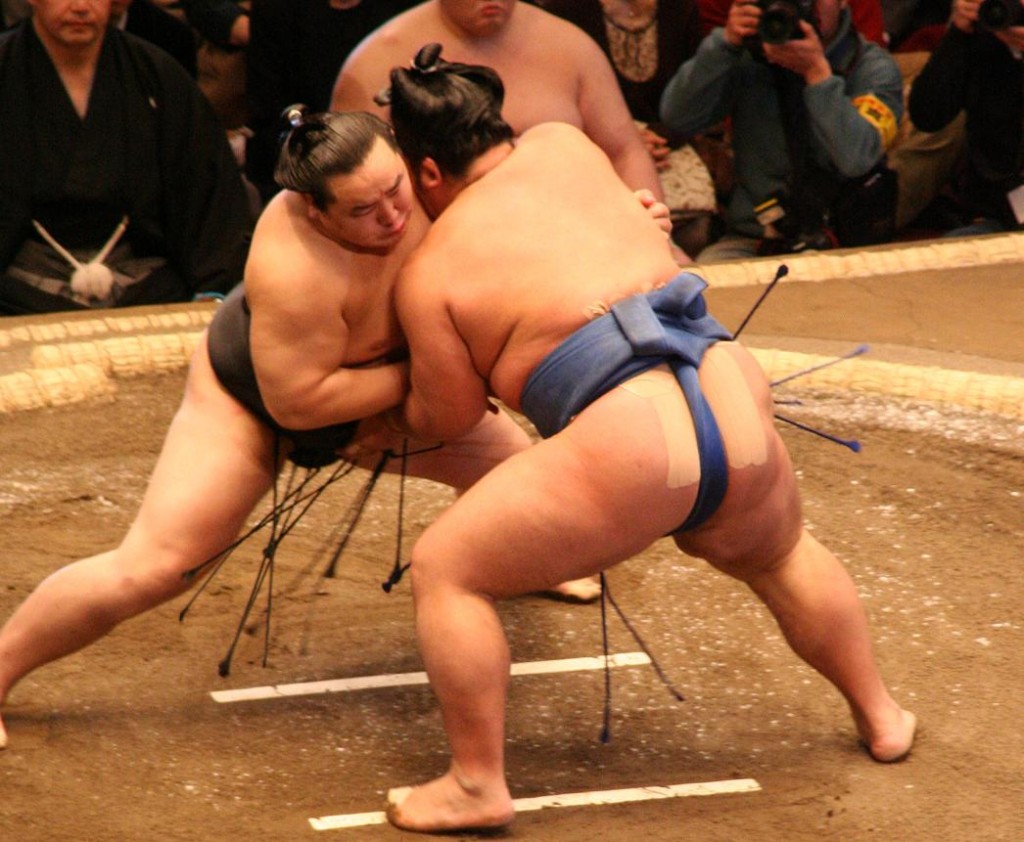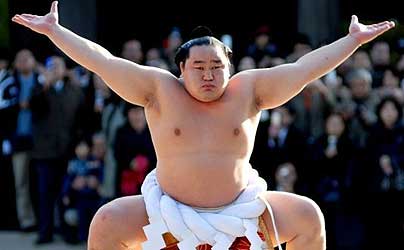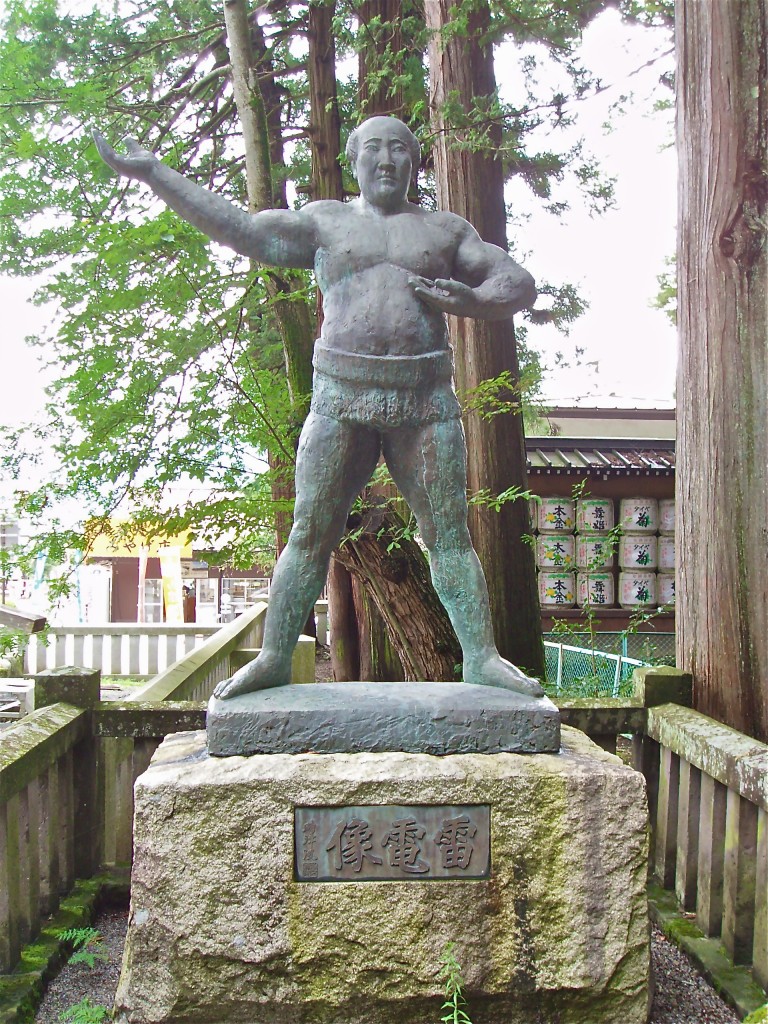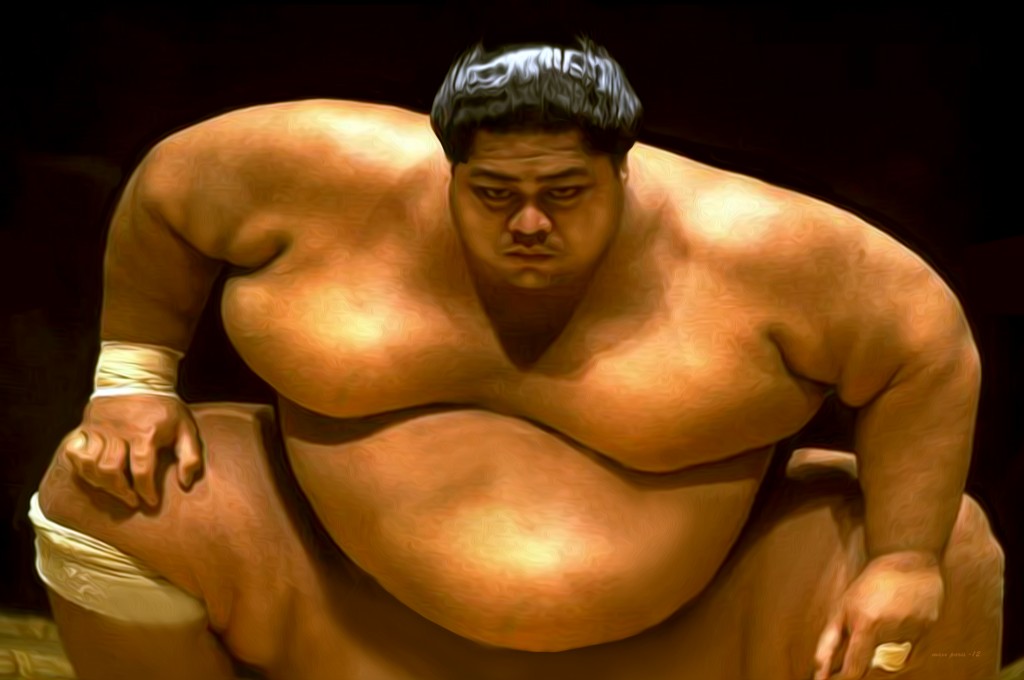
Wikicommons photo of a 2008 fight
With the Osaka tournament currently on day 5 of its two-week span, it’s a timely moment to consider the Shinto origins of the sport (there are six tournaments a year). For anyone familiar with the rituals of sumo, the religious trappings are evident in the etiquette, clothing and the design of the ring. Given the similarities with Mongolian and Korean wrestling, it seems likely that the sport arrived from the continent. Thereafter it developed distinctive features as it was adapted as an entertainment for the kami. In early times these ‘gods’ were deified clan founders whose descendants cultivated their memory. There would have been a strongman element in the contests, with implications for martial and bodyguard duties. This ties in with the sentiments in the first paragraph in the passage below.
For most of sumo history of course, all the wrestlers were Japanese only. It was only in Edo times that it became a spectator sport rather than a purely religious one. It’s said some foreigners tried their luck at the sport in the late nineteenth century, but only after WW2 were serious inroads made. In 1972 the Hawaiian-born Takamiyama Daigoro, whose real name was Jesse Kuhaulua, became the first foreigner to win a tournament.
In 1993 another Hawaiian, Akebono Taro, was the first foreigner to become a grand champion (yokozuna). Six years later another Hawaiian, Musashimaru Koyo, was promoted to yokozuna alongside him. After that, the focus switched to Mongolians as three wrestlers from Ulaanbaatar became yokozuna, including the present record-setting champion, Asashoryu. Now the top ranks include wrestlers from Egypt, Brazil, Georgia, and Bulgaria in addition to Mongolia. Though there was resistance at times and a limit put on the number of foreigners, you could say sumo is one aspect of Shinto that has truly internationalised!
*********************************************************
Shinto origins of sumo (From Wikipedia, slightly modified)
The Shinto origins of sumo can easily be traced back through the centuries and many current sumo rituals are directly handed down from Shinto rituals. The Shinto religion has historically been used as a means to express Japanese nationalism and ethnic identity, especially prior to the end of World War II. In its association with Shinto, sumo has also been seen as a bulwark of Japanese tradition.

The former grand champion, Asahshoryu, was the first person to win all six sumo tournaments in one year. Now retired, he hailed from Mongolia and was criticised for not keeping to traditional standards of modesty, sincerity and propriety.
Sumo can be traced back to ancient Shinto rituals to ensure a bountiful harvest and honor the spirits known as kami. In modern times, the canopy over the sumo ring, called the dohyō is reminiscent of a Shinto shrine, the officiator is dressed in garb very similar to that of a Shinto priest, and the throwing of salt before a bout is believed to purify the ring.
Prior to becoming a professional sport in the Tokugawa period, sumo was originally performed on the grounds of a shrine or temple. The present dohyō, which is still considered sacred, is in honor of the days when matches were held on the sacred grounds of shrines and temples. The roof called yakata originally represented the sky for the purpose of emphasizing the sacred nature of the dohyō, which symbolizes the earth.

Some shrines such as Suwa Taisha have close ties with sumo and honour former champions
On the day before the beginning of each tournament, the dohyō-matsuri, a ring-blessing ceremony, is performed by sumo officials. They are the referees, who judge each sumo match. Their elaborate, colorful costumes are based on ceremonial court robes of the Heian period (AD 794 – 1185). Also their black hats are exact copies of the hats worn by Shinto priests depicted in various Heian art.
Dressed in the white robes of a Shinto priest the officials purify and bless the dohyō in a solemn ceremony during which salt, kelp, dried squid and chestnuts are buried in the center. Observing officials and invited guests drink saké, Japanese rice-wine, as it is offered to each one in turn. The remaining saké is poured over the straw boundary of the dohyō, as an offering to the gods.
Shinto ritual still continues to pervade every aspect of sumo. Before a tournament, two of the sumo officiators functioning as Shinto priests enact a ritual to consecrate the newly constructed dohyō. And each day of the tournament the dohyō-iri, or ring-entering ceremonies performed by the top divisions before the start of their wrestling day, are derived from sumo rituals.
The ceremony involves the wrestlers ascending the dohyō, walking around the edge and facing the audience. They then turn and face inwards, clap their hands, raise one hand, slightly lift the ceremonial aprons, and raise both hands, then continue walking around the dohyō as they leave the same way they came in. This clapping ritual is an important Shinto element and reminiscent of the clapping in Shinto shrines designed to attract the attention of the gods. The yokozuna’s ring-entering ceremony is regarded as a purification ritual in its own right, and is occasionally performed at Shinto shrines for this purpose. Every newly promoted yokozuna performs his first ring-entering ceremony at the Meiji Shrine in Tokyo.
********************************************************
For a listing of the tournaments and dates for the coming couple of years, please this page of the Japan Times.
For an article about the rise of foreign wrestlers in Japan, see this page from McKinsey.com. ********************************************************

The Hawaiian wrestler, Konishiki, had to be seen to be believed. Now retired, he's slimmed considerably and appears occasionally on television – a gentle giant who likes entertaining children. (courtesy prowrestlingsource.com)

Hakuho is doing well
It seems the first sumo fight was actually a brawl between Takemikazuchi no kami and Takeminakata no kami, who latter became the god of Suwa.
Then, in the stupid and tragic bombing of Nagasaki (the Japanese city who was the most open to foreigners, Western values and culture and modernization in general) all the churches and the cathedral were destroyed by the blaze, while the Shinto Shrine of Suwa was intact. Takeminakata beat Jesus.
Do you know about what I am thinking ? SOUTH PARK ! XD
Also, Yokozuna wear shimenawa so they are living Go-Shintai, whatever laic fanatics may say about being or not being God (since they didn’t tried to define “god” in the first place, before stating such things… when the West and politically correct community speak about God it’s most of the time respect and supernatural, not awe and destiny who come to their minds).
Thank you for the comment. I’m not sure where the ‘living go-shintai’ idea comes from? There are shimenawa around many objects regarded as divine, but I don’t think all of them are meant to be regarded as ‘go-shintai’ which is usually the most sacred object in the shrine. Are you suggesting that the kami enter physically into the body of the yokozuna, in shamanic fashion?
The idea is that the rikishi has attained “kami-esque” status by being the best and (though you wouldn’t get most people to admit it) pleasing the kami. If you’d like to know more (but be very careful about how you ask) contact the folks over at http://www.sumoforum.net Also, check out the storm I caused (right before I left the site because, while they know sumo, they apparently are in the dark ages regarding the LGBT community) by writing a note on homosexuality in the ‘Heya’….http://www.sumoforum.net/forums/index.php?showtopic=30108&hl=homosexuality